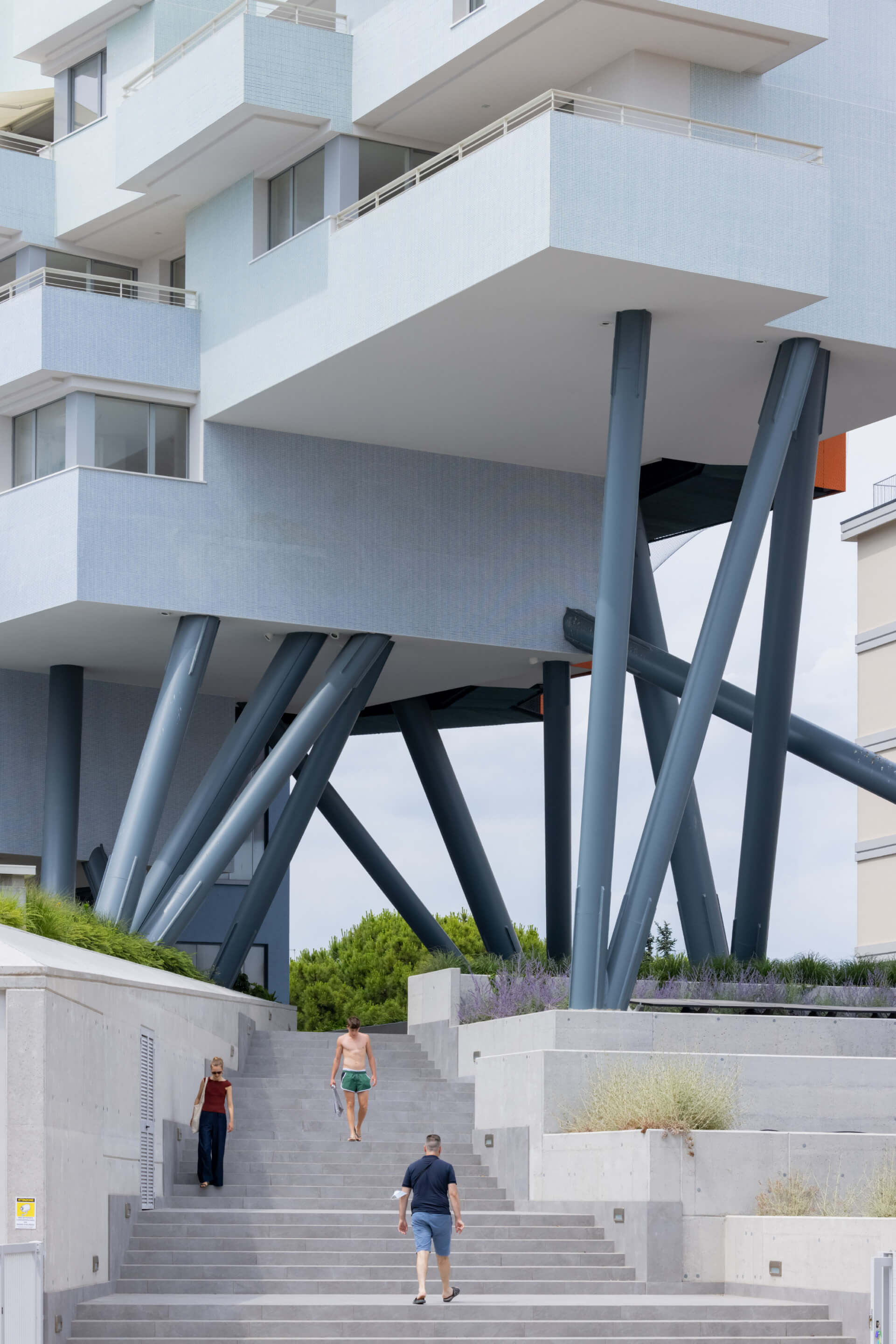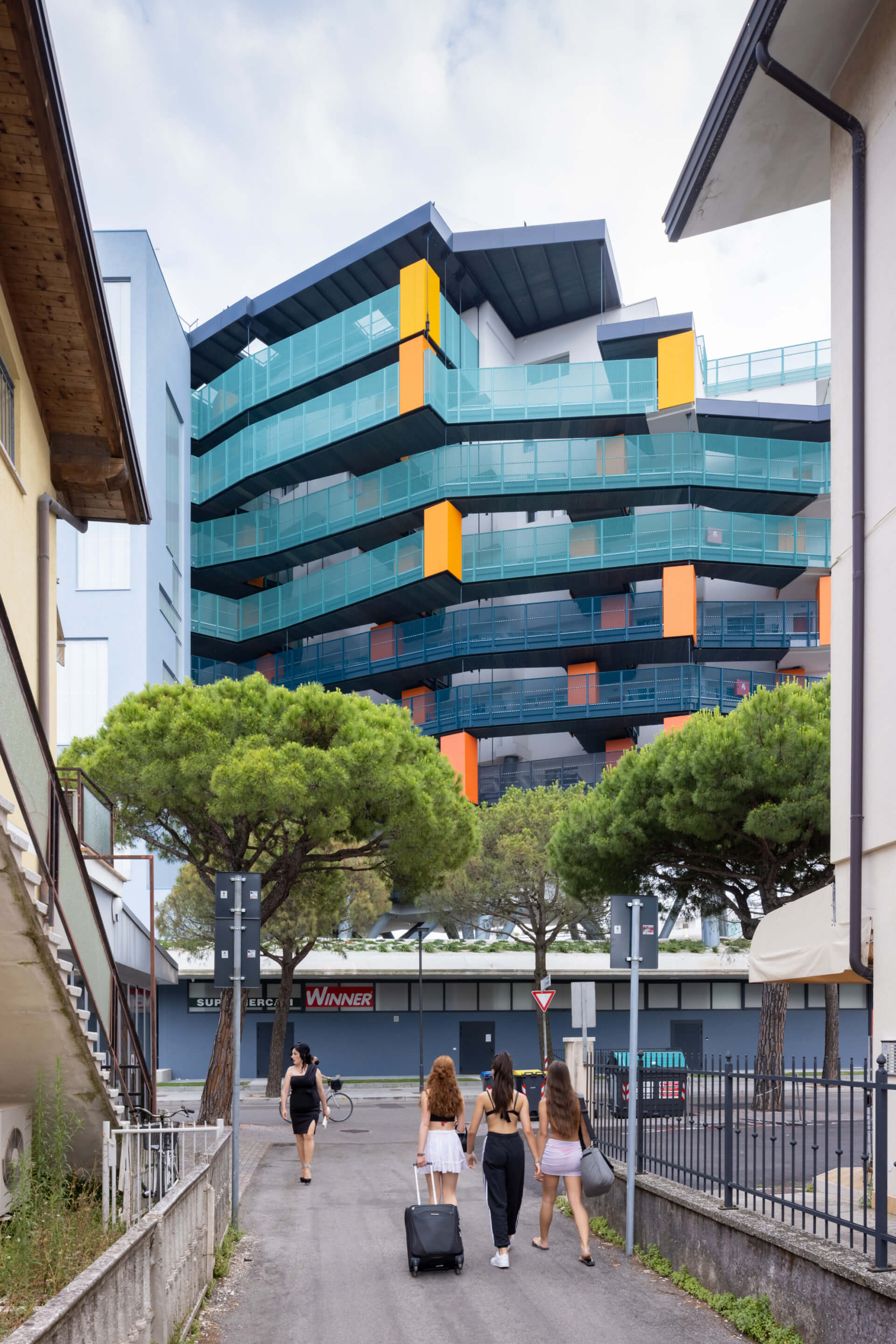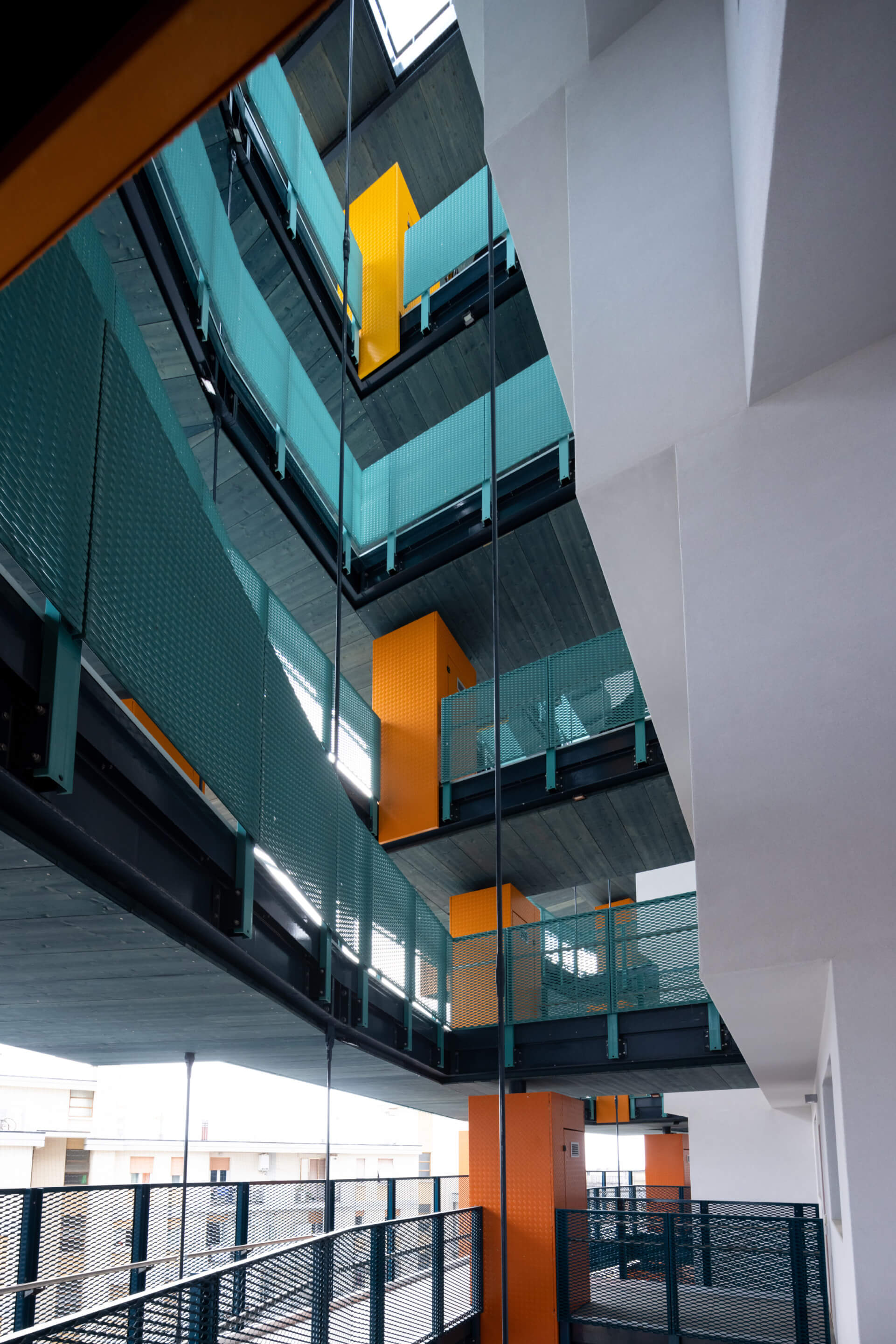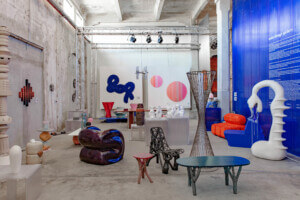Everybody
summertime love
you’ll remember me
everybody
summertime love
be my lover
be my baby
It’s 1987. An upbeat Italo disco sound is pounding as a young bikini-clad Sabrina Salerno sings “Boys, Boys, Boys,” driving the crew boys crazy while dipping in and out of a Smurf-blue pool. These visuals, which laid the foundations for a decades-long aesthetic, belong to the history of European pop culture, while the pool itself belongs to the four-star Hotel Florida in the seaside town of Jesolo, the Venetian Miami Beach.
It’s 2022. A few blocks from Hotel Florida, the crowded built fabric of Lido di Jesolo is shaken up by a new and unexpected visual: a cascading cluster of modular boxes, perched atop slanted stilts, shining brilliantly in the sunlight. Like Salerno emerging from the azure waters, this apparition floats above a sloped retail pedestal, surrounded by a plaza and topped by the turquoise rectangle of a swimming pool.
This building, a high-end housing development called Le bâtiment descendant l’escalier (literally “the building walking down the stairs”), was designed by the Italian firm ELASTICOfarm, led by Stefano Pujatti. The project aims to break with local conventions and maximize value, both urban—by opening up a new connection between the main street and adjacent back streets—and architectural—by providing sunlight to all units, which open onto shared galleries to the north.

Leaving the euphemistic comparisons aside—and this building is a Mies Award nominee, by the way—Le bâtiment prompts two reactions, one impressionistic, the other analytic. First, is this juggernaut walking on slanted stilts amid a quiet coastal fabric of ordinary apartment blocks? Yes, of course it is. And second, what does this indicate about the primacy of context? Since this is an extremely delicate and triggering question in Italy, we need a moment to talk about the Italian notion of “context.”
While it would be impossible to squeeze the vast literature covering the subject into a few lines, it is essentially true that Italy’s contemporary urban landscape is largely a product of postwar thinking, with no connection or respect for the Italian City™ as traded upon worldwide. Jesolo, for example, is tailored to a newly globalized holiday clientele, resulting in enormous amounts of built material, most of which opens on quite ordinary views or, if you’re lucky, the seaside. Meanwhile, the economics of leisure as consumption provide a chance to produce new cultural expressions.
And here we are again, back to Italo disco, Italian summer mythology, and the now much-celebrated aesthetics of the Riviera. Lido di Jesolo is a matter of mental context: Here, what one wants most is the chance to see and be seen. This “show-off society,” per Pujatti, draws visitors from nearby provinces and abroad. It has also attracted the attention of many renowned designers who have sought to make a mark on the place, including Zaha Hadid, Richard Meier, and Gonçalo Byrne, or to partner with local institutions on larger urban design projects, as Kenzo Tange or Aires Mateus & Associados have done.

Pujatti told AN that Le bâtiment was a big break for his office. After studying at SCI-Arc, he spent time working for the Italian master of poetic structure Gino Valle, which is apparent in the way Pujatti’s buildings reflect personal interests and preoccupations. It’s what makes it very difficult to place the work in any geography/style/generation-based category. Instead, visual metaphors and seemingly incongruous material choices, such as the bladelike glass panels and chopped exposed brickwork that characterize the two ends of a florist’s laboratory in the Piedmontese country town of Chieri (2008), predominate. Unlikely transpositions are another compelling device, a good example being the cantilevered stone “curtain” found at the Stoned House in San Quirino (2018).
The Jesolo project expands these themes to an urban scale. It gave Pujatti an opportunity to use form provocatively, hard to do in private residential projects, while also leaving the door open to spontaneity and chance in the design process. “We wanted something to happen, though we didn’t plan that something in advance,” Pujatti said. This can be seen on the southern facade, where the usual pairing of colored tile with white grout has been reversed. This solution, which is typical of bathroom interiors, reacts differently under varied light conditions, allowing the building to change moods by the hour.
Pujatti spoke about “seeking the potential for new expressions in between the meanders of ordinary use,” which is a little like analyzing a dream or memory of a place. It requires one to construct a mental landscape from whatever disparate materials one has at hand. Perhaps this makes a useful frame for Le bâtiment’s more curious moves, such as the sharp contrast between the slender structural columns that gather at points on the ground and the boxy mass they hold aloft. Or the blue-green balconies that overlap on the north elevation and, in doing so, resemble a fishing net.

The intellectual category of “relational context” is apt to describe the construction or collaging of context through the positioning of design concepts toward material, but most of all immaterial, inputs arising from specific situations. This method can be applied in radically different contexts and geographies. To this point, part of Pujatti’s practice is now based in Canada, where a project for the Weengushk Film Institute—designed in collaboration with KFA Architects and Planners—gains its pictorial force through its relationship to the surrounding forest. And a proposal for a Toronto house, called the Maison Glacé, would allow ice to jell on the facades, concretizing a perfect image of the regional landscape.
By the way, Maison Glacé(e) is French for “frosted house,” but sounds a lot like “marron glacé” (sugar-frosted walnuts), a fine confiserie treat immediately evoking another mental landscape, of old-fashioned bourgeois European tearooms. Unfortunately, I wasn’t able to run this interpretation by Pujatti. I suppose I’ll leave it for the next installment of “context-critical architecture.”
Giovanni Comoglio is an architect trained in Turin and Paris. He is a lecturer and teaching assistant at the Politecnico di Milano and teaches History of Architecture at ISAD in Milan.











